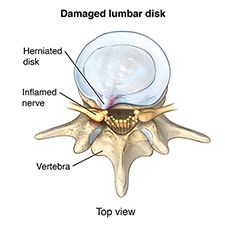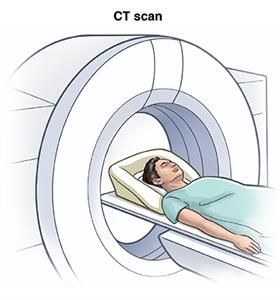Brain and Spine Care
Want to learn more about this at Kettering Health?
What is low back pain?
Low back pain can range from mild, dull, annoying pain, to persistent, severe, disabling pain in the lower back. Pain in the lower back can restrict mobility and interfere with normal functioning.
What causes low back pain?
The exact cause of low back pain can be hard to determine. In most cases, back pain may be a symptom of many different causes, including any of these:

- Overuse, strenuous activity, or improper use (such as repetitive or heavy lifting, exposure to vibration for prolonged periods of time)
- Injury
- Degeneration of vertebrae (often caused by stresses on the muscles and ligaments that support the spine, or the effects of aging)
- Infection
- Abnormal growth (tumor)
- Obesity (often increases weight on the spine and pressure on the disks)
- Poor muscle tone in the back
- Muscle tension or spasm
- Sprain or strain
- Ligament or muscle tears
- Joint problems (such as spinal stenosis)
- Smoking
- Protruding or herniated (slipped) disk
- Disease (such as osteoarthritis, spondylitis, compression fractures)
What are the symptoms of low back pain?
Low back pain is classified as acute (or short term) and chronic. Acute low back pain lasts from a few days to a few weeks. Most acute low back pain will resolve on its own. Chronic low back pain lasts for more than 3 months and often gets worse. The cause of chronic low back pain can be hard to find.
These are the most common symptoms of low back pain. Symptoms may include discomfort or pain in the lower back that is:
- Aching
- Burning
- Stabbing
- Sharp or dull
- Well-defined or vague
The pain may radiate into one or both buttocks or even into the thigh or hip area.
The symptoms of low back pain may look like other health problems. Always see your healthcare provider for a diagnosis.
How is low back pain diagnosed?
Along with a complete medical history and physical exam, tests for low back pain may include:
- X-ray. This test uses electromagnetic energy beams to make images of bones onto film.
- CT scan. This imaging test uses X-rays and computer technology to make detailed images of any part of the body, including the bones, muscles, fat, and organs. CT scans are more detailed than general X-rays.
- MRI. This test uses large magnets and a computer to make detailed images of organs and structures in the body.
- Radionuclide bone scan. This imaging technique uses a very small amount of radioactive material that is injected into the patient’s bloodstream to be detected by a scanner. This test shows blood flow to the bone and cell activity within the bone.
- Electromyogram (EMG). This test checks nerve and muscle function.

How is low back pain treated?
Treatment may include:
- Changes in activity
- Medicine
- Physical rehabilitation, therapy, or both
- Osteopathic manipulation
- Occupational therapy
- Weight loss (if overweight)
- No smoking
- A prevention program (as directed by your healthcare provider)
- Surgery
- Assistive devices (such as mechanical back supports)
Rehabilitation is often a part of treatment for low back pain. Generally, there are 3 phases of low back pain rehab.
- Acute phase. During this initial phase, the physiatrist (a healthcare provider who specializes in rehab medicine) and treatment team develop a plan to reduce the initial low back pain and source of inflammation. This may include using ultrasound, electrical stimulation, or specialized injections.
- Recovery phase. Once the initial pain and inflammation are better managed, the rehab team focuses on helping you return to normal daily activities while starting a specialized exercise program to regain flexibility and strength.
- Maintenance phase. In this phase, you will learn ways to prevent further injury and strain to the back. You will also learn how to start a fitness program to help further increase strength and endurance.
What can I do to prevent low back pain?
The following may help to prevent low back pain:
- Use correct lifting techniques.
- Maintain correct posture while sitting, standing, and sleeping.
- Exercise regularly (with proper stretching beforehand).
- Don’t smoke.
- Maintain a healthy weight.
- Reduce stress, which may cause muscle tension.
When should I call my healthcare provider?
Call your healthcare provider if:
- Your pain becomes worse or spreads to your hips, thighs, or legs.
- Your pain medicine no longer works well for you.
- Your pain begins to interfere with your daily activities, or interferes with activities more than usual.
Living with low back pain
Most back pain will ease in a few days to a few weeks. If the pain lasts longer than 3 months, it is considered chronic and you should talk with your healthcare provider. Recovery from low back pain can take time. To prevent back pain from coming back, it’s important to follow good health practices, such as:
- Maintaining a healthy weight
- Exercising regularly
- Practicing good lifting techniques
- Maintaining good posture while sitting, standing, and sleeping
- Not smoking
Key points about low back pain
- Specific treatment for low back pain depends on the cause of the pain and the severity. But it often includes pain medicines and muscle relaxers, physical therapy, and assistive devices such as a back support. It also may include lifestyle changes such as stress reduction, weight loss, and increased physical activity.
- A back rehab program may be used as part of the treatment for low back pain.
- Measures to prevent back pain include using safe lifting techniques, maintaining correct posture, staying at a healthy weight, not smoking, and reducing stress.
Next steps
Tips to help you get the most from a visit to your healthcare provider:
- Know the reason for your visit and what you want to happen.
- Before your visit, write down questions you want answered.
- Bring someone with you to help you ask questions and remember what your provider tells you.
- At the visit, write down the name of a new diagnosis, and any new medicines, treatments, or tests. Also write down any new instructions your provider gives you.
- Know why a new medicine or treatment is prescribed, and how it will help you. Also know what the side effects are.
- Ask if your condition can be treated in other ways.
- Know why a test or procedure is recommended and what the results could mean.
- Know what to expect if you do not take the medicine or have the test or procedure.
- If you have a follow-up appointment, write down the date, time, and purpose for that visit.
- Know how you can contact your provider if you have questions.





